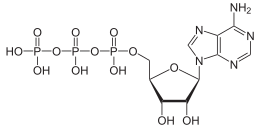ATP hydrolysis



ATP hydrolysis is the reaction by which chemical energy that has been stored in the high-energy phosphoanhydride bonds in adenosine triphosphate (ATP) is released, for example in muscles, by producing work in the form of mechanical energy. The product is adenosine diphosphate (ADP) and an inorganic phosphate, orthophosphate (Pi). ADP can be further hydrolyzed to give energy, adenosine monophosphate (AMP), and another orthophosphate (Pi). ATP hydrolysis is the final link between the energy derived from food or sunlight and useful work such as muscle contraction, the establishment of electrochemical gradients across membranes, and biosynthetic processes necessary to maintain life.
The description and typical textbook labeling anhydridic bonds as "high energy . . bonds" can be very misleading to students. These bonds are in fact relatively weak. They do involve high energy electrons but the bonds themselves are quite easy to break. As noted below, energy is released by the hydrolysis of ATP when these weak bonds are broken - requiring a small input of energy, followed by the formation of new bonds and the release of a larger amount of energy as the total energy of the system is lowered and becomes more stable.
Hydrolysis of the phosphate groups in ATP is especially exergonic, because the resulting orthophosphate group is greatly stabilized by multiple resonance structures, making the products (ADP and Pi) much lower in energy than the reactant (ATP). The high negative charge density associated with the three adjacent phosphate units of ATP also destabilizes the molecule, making it higher in energy. Hydrolysis relieves some of these electrostatic repulsions, liberating useful energy in the process by causing conformational changes in enzyme structure.
Hydrolysis of the terminal phosphoanhydridic bond is a highly exergonic process, releasing 30.5 kJ mol−1 energy. This reaction can then be coupled with thermodynamically unfavorable reactions to give an overall negative (spontaneous) ΔG for the reaction sequence. The actual value of ΔG for ATP hydrolysis varies, primarily depending on Mg2+ concentration, and under normal physiologic conditions is actually closer to -50 kJ mol−1.
In humans, approximately 60 percent of the energy released from the hydrolysis of one mole of ATP produces metabolic heat rather than fuel the actual reactions taking place.
Due to the acid-base properties of ATP, ADP, and inorganic phosphate, the hydrolysis of ATP has the effect of lowering the pH of the reaction medium.[1] Under certain conditions, high levels of ATP hydrolysis can contribute to lactic acidosis.
See also
References
- ↑ "Archived copy". Archived from the original on 2012-02-22. Retrieved 2010-09-16.
Syberg, F. Suveyzdis, Y., Kotting, C., Gerwert K., & Hofmann, E. Time-Resolved Fourier Transform Infrared Spectroscopy of the Nucleotide-binding Domain from the ATP-binding Cassette Transporter MsbA: ATP HYDROLYSIS ID THE RATE-LIMITING STEP IN THE CATALYTIC CYCLE. Journal of Biological Chemistry, 278(28), 23923-23931 doi:10.1074/jbc.M112.359208
Zharova, T.V, & Vinogradov, Proton-Translocating ATP-synthase of Paracoccus denitrificans: ATP- Hydrolytic Activity. Biochemistry (00062979:, 68(10), A.D. (2003). 1101-1108
Kamerlin, S. C., & Warshel, A. (2009). On the energetics of ATP hydrolysis in solution. The Journal of Physical Chemistry B, 113(47), 15692-15698.
Bergman, C., Kashiwaya, Y., & Veech, R. L. (2010) The effect of pH and Free Mg2+ on ATP Linked Enzymes and the Calculation of Gibbs Free Energy of ATP Hydrolysis. Journal of Physical Chemistry B, 114 (49), 16137-16146.
Berg, J. M., Tymoczko, J. L., Stryer, L., Biochemistry, international edition. W. H. Freeman.; New York, New York, 2011; p 287